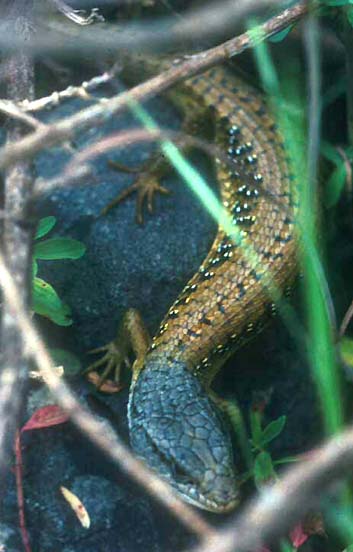 |
 Three
alligator lizards inhabit California, and two of them are widespread: Southern
Alligator Lizard Elgaria multicarinata (above; photo
taken in Monterey Co.) and Northern Alligator Lizard E. coerulea
(right; from Del Norte Co.). There are 8 species of alligator lizards
in this genus in a family of about 100 lizards, mostly New World denizens
but of Asiatic distribution as well (Stebbins 2003) Despite the names,
the California ranges of Southern and Northern Alligator Lizards overlap
broadly in northern California in both the coast ranges and the Sierran
foothills, but only the Southern occurs south of Monterey Co. and south
of the Sierra in southern California. The Southern Alligator Lizard generally
prefers drier habitats but both are usually found near water. In addition,
the Panamint Alligator Lizard E. panamintina occurs in the
Panamint, White, and Inyo Mts. of s. Mono and Inyo counties. Three
alligator lizards inhabit California, and two of them are widespread: Southern
Alligator Lizard Elgaria multicarinata (above; photo
taken in Monterey Co.) and Northern Alligator Lizard E. coerulea
(right; from Del Norte Co.). There are 8 species of alligator lizards
in this genus in a family of about 100 lizards, mostly New World denizens
but of Asiatic distribution as well (Stebbins 2003) Despite the names,
the California ranges of Southern and Northern Alligator Lizards overlap
broadly in northern California in both the coast ranges and the Sierran
foothills, but only the Southern occurs south of Monterey Co. and south
of the Sierra in southern California. The Southern Alligator Lizard generally
prefers drier habitats but both are usually found near water. In addition,
the Panamint Alligator Lizard E. panamintina occurs in the
Panamint, White, and Inyo Mts. of s. Mono and Inyo counties.
Alligator lizards can give a nasty bit when caught, so I don't try to catch them. Yet all the older literature (e.g., Stebbins 1966, Brown 1974) emphasize the importance of looking at the pattern on the underside of the lizard: Northern has dark longitudinal lines between the scales whilst Southern has lines or dashes down the center of the scales. One is also told to count the number of scales in certain rows. I find these point exceptionally frustrating since I'm never looking at the bottom of the lizard! Even the new literature (Stebbins 2003) puts emphasis of these points. Perhaps this is because many herpetologists are looking at specimens in which eye color cannot be determined. More recent literature (Basey 1976, Stebbins 1985, 2003) do point out that eye color much more readily separates Southern Alligator Lizard (yellow eyes; top photo) from Northern Alligator Lizard (dark eyes; below — same lizard as right). [Panamint is also a yellow-eyed lizard.] Now that is the type of character a birder can really get a grip on! But somehow I had completely overlooked this point and, because I had relied on painted differences of back pattern in Brown (1974), all of my photos of alligator lizards were misidentified! Apparently both species can like the top lizard, although Southern is more heavily cross-banded on average, and apparently both species can be gray-headed and brown-bodied. I now note, however, that Stebbins (2003) states that it is the Shasta Alligator Lizard E. c. shastensis — the subspecies of Northern that occurs in northernmost California where my photos here were taken — that is said to have "head may be slate gray and body yellowish green or tan." |
